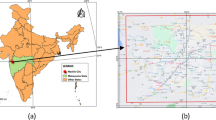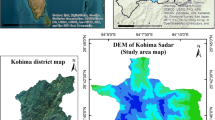Abstract
Rapid urbanization with an increasing rate of urban built-up area is decreasing urban green space resulting in changing urban microclimate conditions showing increasing land surface temperature. A better understanding of these effects is important to formulate effective strategies in addressing the impact of increasing built-up area. Land surface temperature patterns in an urbanized city in Bangladesh (Mymensingh district) were investigated using Landsat satellite sensor data from 1988 to 2016. A total of nineteen Landsat satellite images were used to retrieve land surface temperature (LST), normalized difference vegetation index (NDVI), and normalized difference built-up index (NDBI). The radiative transfer equation (RTE) model was applied to derive LST for the years 1988, 1992, 1999, 2004, 2008, 2012, and 2016. Further, the Landsat-derived LST results were compared with MODIS Terra satellite outputs (MOD11A1) for the validation of our study results. Our results showed NDVI higher in 2008 and lower in 2004, LST maximum in 1988 and minimum in 2008, and NDBI higher in 2004 and lower in 2012. Seasonally, summer was characterized by higher LST and winter by lower LST, while NDVI was higher in autumn and lower in winter, however, NDBI was higher in winter and lower in autumn. Spatially, a relatively higher LST and NDBI was observed in the southwest, followed by central, and northern regions, whereas the trend was opposite for NDVI. Using Pearson’s correlation, results showed a strong significant negative correlation between LST and NDVI and a positive significant correlation between LST and NDBI. Further, simple linear regression analysis revealed that LST decreased with increasing NDVI most quickly in 2012, followed by the years 2016, 2008, 1992, 1988, 1999, and 2004. On the other hand, LST increased with increasing NDBI most quickly in 1999, followed by the years 2016, 1988, 1992, 2012, 2004, and 2008. Thus, long-term observation suggested that urbanization had driven a decrease in green space while simultaneously increasing the land surface temperature within an urbanized area. This study has concluded that the protection of urban green spaces is needed as an effective step toward addressing adverse effects of regional climate change and desertification.
Graphical abstract








Similar content being viewed by others
Data availability
United States Geological Survey (USGS) website (https://earthexplorer.usgs.gov).
Abbreviations
- DN:
-
Digital number
- ETM+:
-
Enhanced Thematic Mapper Plus
- LSE:
-
Land surface emissivity
- NSIDC:
-
National Snow and Ice Data Center
- OLI:
-
Operational Land Imager
- RTE:
-
Radiative transfer equation
- TIRS:
-
Thermal Infrared Sensor
- TM:
-
Thematic Mapper
- USGS:
-
United States Geological Survey
References
Abir FA, Saha R (2021) Assessment of land surface temperature and land cover variability during winter: a spatio-temporal analysis of Pabna municipality in Bangladesh. Environ Challenges 4:100167
Ahmed B, Kamruzzaman MD, Zhu X, Rahman M, Choi K (2013) Simulating land cover changes and their impacts on land surface temperature in Dhaka, Bangladesh. Remote Sensing 5(11):5969–5998
Alademomi AS, Okolie CJ, Daramola OE, Agboola RO, Salami TJ (2020) Assessing the relationship of LST, NDVI and EVI with land cover changes in the Lagos lagoon environment. Quaest Geographicae 39(3):87–109
Bindhu VM, Narasimhan B, Sudheer KP (2013) Development and verification of a non-linear disaggregation method (NL-DisTrad) to downscale MODIS land surface temperature to the spatial scale of Landsat thermal data to estimate evapotranspiration. Remote Sens Environ 135:118–129
Chaudhuri G, Mishra NB (2016) Spatio-temporal dynamics of land cover and land surface temperature in Ganges-Brahmaputra delta: a comparative analysis between India and Bangladesh. Appl Geogr 68:68–83
Chan HP, Chang CP, Dao PD (2018) Geothermal anomaly mapping using Landsat ETM+ data in Ilan Plain, Northeastern Taiwan. Pure and Applied Geophysics 175(1):303–323
Chen LY, Li MY, Huang F, Xu SL (2013) Relationships of LST to NDBI and NDVI in Wuhan City based on Landsat ETM+ image. 6th International Congress on Image and Signal Processing (CISP) 2:840–845
District Statistics (2011) Mymensingh. Available online: (http://203.112.218.65:8008/WebTestApplication/userfiles/Image/District%20Statistics/Mymensingh.pdf). Last visited/retrieved on 2020.10.30
Ghobadi Y, Pradhan B, Shafri HZM, Kabiri K (2015) Assessment of spatial relationship between land surface temperature and landuse/cover retrieval from multi-temporal remote sensing data in South Karkheh Sub-basin, Iran. Arab J Geosci 8(1):525–537
Guha S, Govil H, Dey A, Gill N (2018) Analytical study of land surface temperature with NDVI and NDBI using Landsat 8 OLI and TIRS data in Florence and Naples City, Italy. Eur J Remote Sens 51(1):667–678
Guha S, Govil H (2021) An assessment on the relationship between land surface temperature and normalized difference vegetation index. Environ Dev Sustain 23:1944–1963
Guha S, Govil H, Diwan P (2020) Monitoring LST-NDVI relationship using Premonsoon Landsat datasets. Adv Meteorol 4539684:15. https://doi.org/10.1155/2020/4539684
He J, Zhao W, Li A, Wen F, Yu D (2019) The impact of the terrain effect on land surface temperature variation based on Landsat-8 observations in mountainous areas. Int J Remote Sens 40(5–6):1808–1827
How JinAik D, Ismail MH, Muharam FM (2020) Land use/land cover changes and the relationship with land surface temperature using Landsat and MODIS imageries in Cameron Highlands, Malaysia. Land 9(10):372
IsayaNdossi M, Avdan U (2016) Application of open-source coding technologies in the production of land surface temperature (LST) maps from Landsat: a PyQGIS plugin. Remote Sens 8(5):413. https://doi.org/10.3390/rs8050413
Khandelwal S, Goyal R, Kaul N, Mathew A (2018) Assessment of land surface temperature variation due to change in elevation of area surrounding Jaipur, India. Egypt J Remote Sens Space Sci 21(1):87–94
Khatun MA, Rashid MB, Hygen HO (2016) Climate of Bangladesh. Bangladesh Meteorological Department Technical Report 08/2016, pp 1–158
Krtalić A, Divjak AK, Čmrlec K (2020) Satellite-driven assessment of surface urban heat islands in the city of Zagreb, Croatia. ISPRS Ann Photogramm Remote Sens Spat Inf Sci 3:757–764
Kumar D, Shekhar S (2015) Statistical analysis of land surface temperature–vegetation indexes relationship through thermal remote sensing. Ecotoxicol Environ Saf 121:39–44
Kumari B, Tayyab M, Mallick J, Khan MF, Rahman A (2018) Satellite-driven land surface temperature (LST) using Landsat 5, 7 (TM/ETM+ SLC) and Landsat 8 (OLI/TIRS) data and its association with built-up and green cover over urban Delhi, India. Remote Sens Earth Syst Sci 1(3):63–78
Kumari B, Tayyab M, Ahmed IA, Baig MRI, Khan MF, Rahman A (2020) Longitudinal study of land surface temperature (LST) using mono-and split-window algorithms and its relationship with NDVI and NDBI over selected metro cities of India. Arab J Geosci 13(19):1–19
Macarof P, Groza S, Statescu F (2018) Investigating correlation LST and vegetation indices using Landsat images for the warmest month: a case study of Iasi County. Annals of Valahia University of Targoviste. Geographical Series 18(1):33–40
Maithani S, Nautiyal G, Sharma A (2020) Investigating the effect of lockdown during COVID-19 on land surface temperature: study of Dehradun City, India. J Indian Soc Remote Sens 48(9):1297–1311
Mallick J, Rahman A (2012) Impact of population density on the surface temperature and micro-climate of Delhi. Curr Sci 102(12):1708–1713
Mancino G, Ferrara A, Padula A, Nolè A (2020) Cross-comparison between Landsat 8 (OLI) and Landsat 7 (ETM+) derived vegetation indices in a Mediterranean environment. Remote Sens 12(2):291. https://doi.org/10.3390/rs12020291
Marzban F, Sodoudi S, Preusker R (2018) The influence of land-cover type on the relationship between NDVI–LST and LST-T air. Int J Remote Sens 39(5):1377–1398
Mukherjee F, Singh D (2020) Assessing land use–land cover change and its impact on land surface temperature using LANDSAT data: a comparison of two urban areas in India. Earth Syst Environ 4(2):385–407
Nse OU, Okolie CJ, Nse VO (2020) Dynamics of land cover, land surface temperature and NDVI in Uyo City, Nigeria. Sci Afr 10:e00599. https://doi.org/10.1016/j.sciaf.2020.e00599
Ogashawara I, Bastos VDSB (2012) A quantitative approach for analyzing the relationship between urban heat islands and land cover. Remote Sens 4(11):3596–3618
Oguz H (2013) LST calculator: A program for retrieving land surface temperature from Landsat TM/ETM+ imagery. Environ Eng Manag J 12(3):549–555
Purevdorj TS, Tateishi R, Ishiyama T, Honda Y (1998) Relationships between percent vegetation cover and vegetation indices. Int J Remote Sens 19(18):3519–3535
Rashid KJ, Hoque MA, Esha TA, Rahman MA, Paul A (2021) Spatiotemporal changes of vegetation and land surface temperature in the refugee camps and its surrounding areas of Bangladesh after the Rohingya influx from Myanmar. Environ Dev Sustain 23(3):3562–3577
Stathopoulou M, Cartalis C, Petrakis M (2007) Integrating Corine Land Cover data and Landsat TM for surface emissivity definition: application to the urban area of Athens, Greece. Int J Remote Sens 28(15):3291–3304
Tariq A, Riaz I, Ahmad Z, Yang B, Amin M, Kausar R, Rafiq M (2020) Land surface temperature relation with normalized satellite indices for the estimation of spatio-temporal trends in temperature among various land use land cover classes of an arid Potohar region using Landsat data. Environ Earth Sci 79(1):1–15
USGS (2019a) Landsat 7 (L7) Data users handbook. Available online: https://www.usgs.gov/media/files/landsat-7-data-usershandbook. Last visited/retrieved on 2020.12.20
USGS (2019b) Landsat 8 (L8) Data users handbook. Available online: https://www.usgs.gov/media/files/landsat-8-data-usershandbook. Last visited/retrieved on 2020.12.20
Vázquez DP, Reyes FO, Arboledas LA (1997) A comparative study of algorithms for estimating land surface temperature from AVHRR data. Remote Sens Environ 62(3):215–222
Vlassova L, Pérez-Cabello F, Mimbrero MR, Llovería RM, García-Martín A (2014) Analysis of the relationship between land surface temperature and wildfire severity in a series of Landsat images. Remote Sens 6(7):6136–6162
Young NE, Anderson RS, Chignell SM, Vorster AG, Lawrence R, Evangelista PH (2017) A survival guide to Landsat preprocessing. Ecology 98(4):920–932
Yuan X, Wang W, Cui J, Meng F, Kurban A, De Maeyer P (2017) Vegetation changes and land surface feedbacks drive shifts in local temperatures over Central Asia. Sci Rep 7(1):1–8
Yu X, Guo X, Wu Z (2014) Land surface temperature retrieval from Landsat 8 TIRS—comparison between radiative transfer equation-based method, split window algorithm and single channel method. Remote Sens 6(10):9829–9852
Zhang Z, He G (2013) Generation of Landsat surface temperature product for China, 2000–2010. Int J Remote Sens 34(20):7369–7375
Zhang Y, Odeh IO, Ramadan E (2013) Assessment of land surface temperature in relation to landscape metrics and fractional vegetation cover in an urban/peri-urban region using Landsat data. Int J Remote Sens 34(1):168–189
Zhang F, Kung H, Johnson VC, LaGrone BI, Wang J (2018) Change detection of land surface temperature (LST) and some related parameters using Landsat image: a case study of the Ebinur Lake watershed, Xinjiang, China. Wetlands 38(1):65–80
Author information
Authors and Affiliations
Contributions
MAA and MMH: conceived the idea and developed the methodology. MMH and MLH: collected data and wrote the first draft. MAA and MMH: validation and visualization. AHMK, MHA, and MHI: critically reviewed, corrected, and revised the manuscript. All authors approved the final version of the manuscript and agreed to submit it.
Corresponding author
Ethics declarations
Ethics approval
Not applicable.
Consent to participate
Not applicable.
Consent for publication
Not applicable.
Conflict of interest
The authors declare no competing interests.
Additional information
Responsible Editor: Philippe Garrigues
Publisher's note
Springer Nature remains neutral with regard to jurisdictional claims in published maps and institutional affiliations.
Supplementary Information
Below is the link to the electronic supplementary material.
Rights and permissions
About this article
Cite this article
Hasan, M., Hassan, L., Al, M.A. et al. Urban green space mediates spatiotemporal variation in land surface temperature: a case study of an urbanized city, Bangladesh. Environ Sci Pollut Res 29, 36376–36391 (2022). https://doi.org/10.1007/s11356-021-17480-9
Received:
Accepted:
Published:
Issue Date:
DOI: https://doi.org/10.1007/s11356-021-17480-9




